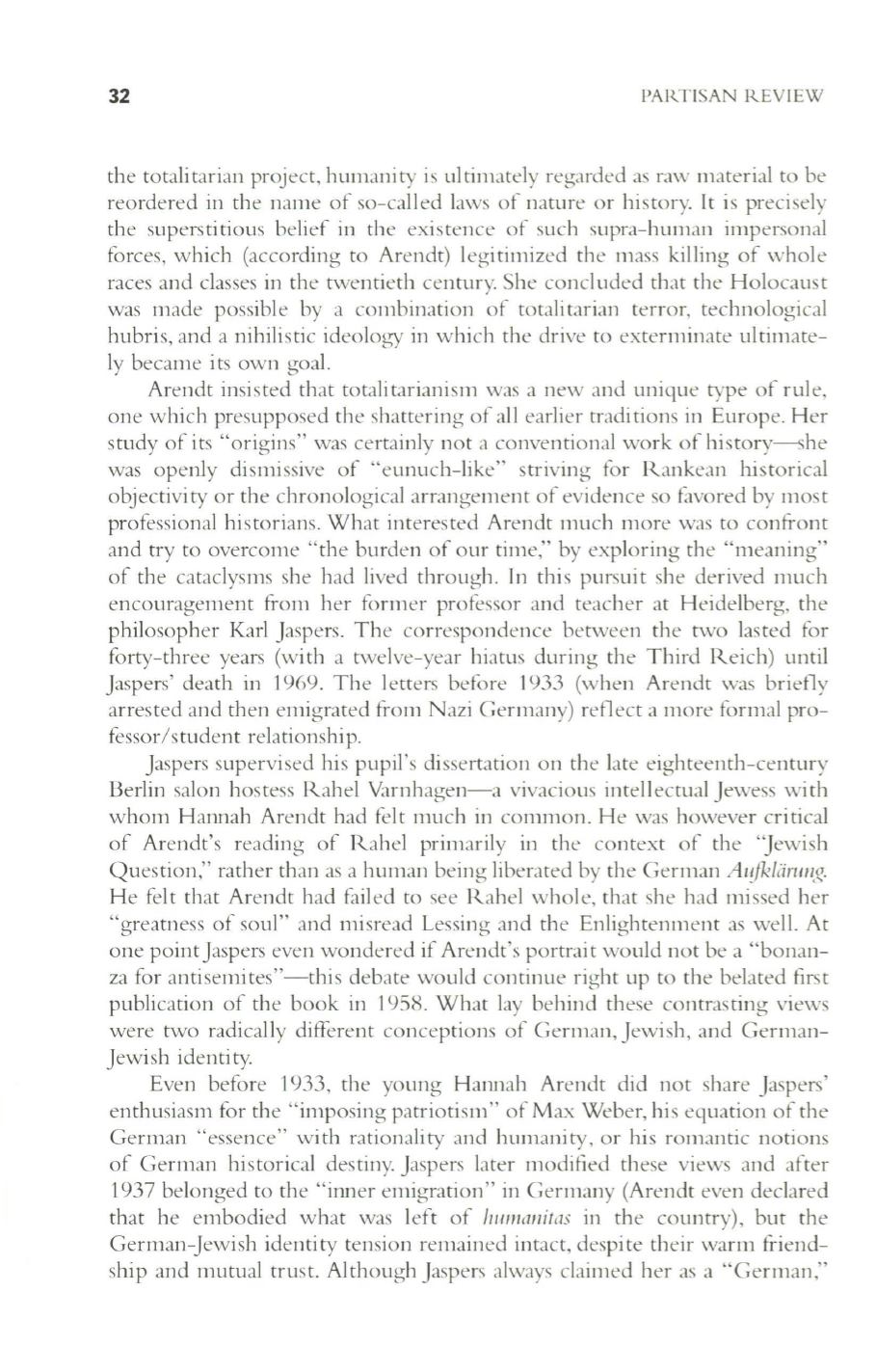
32
PART ISAN FUV IEW
the to talitarian proj ect, humani ty is ul timately rega rded as raw materi al to be
reordered in th e name of so-call ed laws of nature or hi sto ry.
It
is precisely
the superstiti ous beli ef in th e existence o f such supra-human impersonal
fo rces, w hi ch (according to Arendt) legitimi zed the mass killing of whole
races and classes in the twentieth century. Sh e concl uded that the Ho locaust
was made possibl e by a combinati on of totalitarian terro r, techno logical
hubri s, and a nihili sti c ideo lob'Y in whi ch the drive to exterl11inate ultimate–
ly became its own goal.
Arendt insi sted that to talitari ani sm was a new and unique type o f rul e,
one whi ch presupposed the shattering of all earli er tradi ti ons in Europe. Her
study o f its " ori gins" was certainl y no t a conventio nal wo rk o f hi sto ry-she
was openl y di smi ssive of "eunuch- like" striving fo r R ankean hi sto ri cal
obj ectivity or the chronological arrangement of evidence so favo red by 1110s t
professional hi sto rians. What interes ted Arendt much more was to confi'on t
and try to overcome " the burden of our time," by explorin g the " mean ing"
of the ca taclys ms she had li ved through . In thi s pu rsuit she derived mu ch
encouragement from her former pro fessor and teacher at Heidelberg, the
philosopher Karl Jaspers. The co rrespondence between the two las ted for
fo rty- three years (with a twel ve-yea r hi atu s durin g th e Third R eich) until
Jaspers' death in 1969 . The letters befo re 1933 (when Arendt was briefl y
arres ted and th en emi grated from N azi Germany) refl ect a mo re formal pro–
fessor/s tudent relati onship.
Jaspers supervi sed hi s pupil 's di ssertati on on the late eighteenth-century
Berlin salon hos tess R ahel Varnhage n-a vivacious intell ectual Jewess w ith
whom Hannah Arendt had felt much in common. He was however cri ti cal
of Arendt's reading of
r~a hel
primaril y in th e context o f th e "Jewi sh
Ques ti on," rather than as a human being liberated by the German
A lifkldYlIII.fZ.
He felt that Arendt had fail ed to see R ahel who le, that she had mi ssed her
"greatn ess of soul " and mi sread Lessing and the Enli ghtenl11 ent as well. At
on e po intJaspers even wondered if Arendt's portrait would no t be a "bo nan–
za for anti semites"-thi s debate would continue ri ght up to the belated first
publicati on of th e book in 1958. What lay behind th ese contras ting views
were two radi call y different conceptions o f German, Jewi sh, and German–
Jewi sh identity.
Eve n befo re 1933, the young Hannah Arendt did not share Jaspers'
enthusiasm for the " imposing patri o ti sm" of Max Weber, hi s equation o f the
German "essence" wi th rati onali ty and humani ty, or his romanti c no ti ons
of German hi stori ca l des tin y. Jaspers later modifi ed these views and after
1937 belonged to the " inn er emi grati on " in Gerl11 any (Arendt even declared
that he embodied what was left of
1lIllIlalli/as
in the coun try) , but the
German-Jewi sh identity tension remain ed intac t, despite their warm fi'iend–
ship and mutual trust. Alth ough Jaspers always claimed her as a " German ,"


